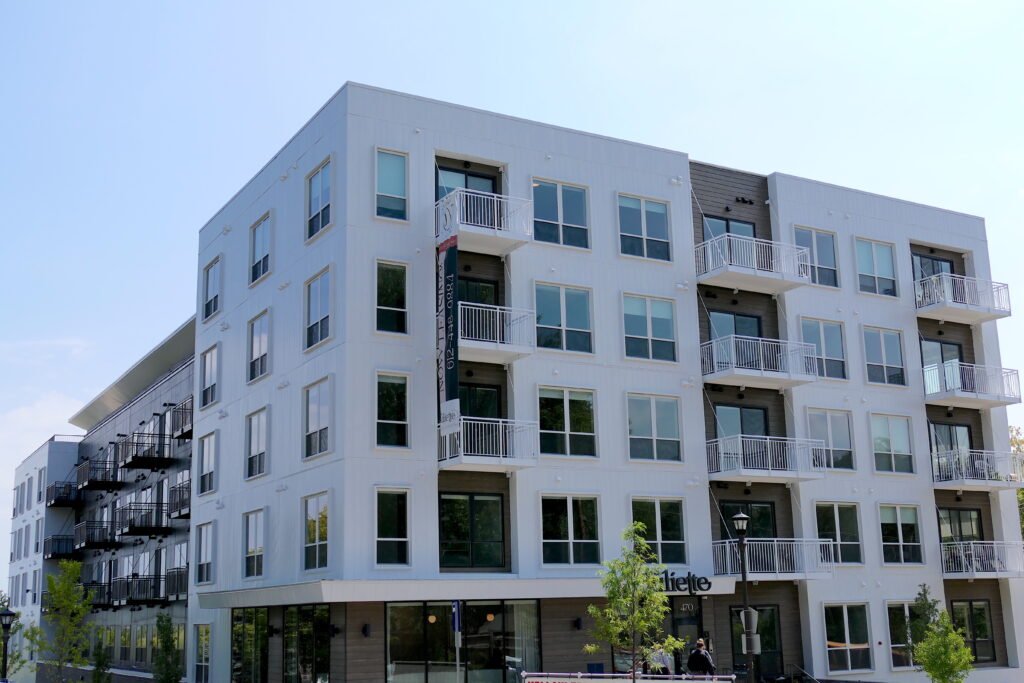Ending Minimum Parking Requirements Was a Policy Win for the Twin Cities
This article was originally published in Minnesota Reformer. It is shared here with permission.
The developer of the newly constructed Juliette apartment building in St. Paul included more apartments and fewer parking spaces as a result of the city eliminating minimum parking requirements. (Source: Max Nesterak/Minnesota Reformer.)
Three years ago, anybody constructing a building in most parts of St. Paul or Minneapolis would have had to deal with a long set of parking requirements. These requirements ranged from seemingly reasonable (though arbitrary) to fully absurd.
St. Paul, for example, required an apartment building to have one parking space for each one- or two-bedroom unit, but more parking for bigger units. Meanwhile, St. Paul golf courses would need four parking spaces per hole, but their mini golf courses would need just one space per hole.
Today, these rules are gloriously gone: if you’re constructing a new building, you can build as few parking spaces as you deem prudent. In 2021, both St. Paul and Minneapolis voted to fully eliminate minimum parking requirements from their zoning codes.
By ending strict minimum parking requirements, the Twin Cities have been able to improve both housing affordability and our urban form. Based on evidence both local and from across the country, it’s becoming clear that this is a winning policy choice.
The case for eliminating parking requirements centers on the idea, largely popularized by scholar Donald Shoup, that minimum parking mandates don’t consistently reflect the actual demand for parking, relative to the cost of supplying it. The appropriate amount of parking will be different for every building based on its land cost, proximity to transit, and customer base, among numerous other factors.
In some instances, developers or tenants are willing to pay for more parking spaces than required by law, but parking mandates often result in buildings with more parking than developers would otherwise choose.
This creates a host of problems. Parking takes up a lot of space and is costly to build, whether you put it on a surface lot or in a garage (a 2021 estimate pegged the average above-ground parking structure at $27,000 per spot, and much higher if you’re digging below ground). These costs drive up rents, or else make housing projects unfeasible to build, at all.
When parking mandates force excess parking spots, they also subtly reshape our transportation choices across a city. Excess parking makes car travel excessively easy, acting as a subsidy to car trips over other travel options—despite the pollution and traffic externalities that cars create. It also results in what journalist Henry Grabar terms “parkitecture,” or a sacrifice of our urban form and design at the altar of parking lots.
At the same time, eliminating parking minimums doesn’t cause off-street parking to disappear entirely. Even when apartment developers aren’t required to build parking spots, many prospective residents will still want parking (and be willing to pay for it). A world without parking requirements will still have parking, but supplied in quantities responsive to actual demand.
Recent empirical research shows how parking reform has played out in other cities. Earlier this year, researcher Catie Gould at the Sightline Institute highlighted two recent academic studies that analyzed housing developments in cities that eliminated or reduced parking requirements.
Examining Seattle and Buffalo, the researchers tracked development after parking minimum elimination to see how new buildings responded to the relaxed rules. As Gould described, Seattle and Buffalo are completely different housing markets; one is a booming coastal city while the other is an older industrial city with less than half of its 1960 population.
Yet in both instances, the majority of post-reform buildings took advantage of their new flexibility and built less parking than was previously mandated. In both cities, parking reform helped increase the overall supply of homes, reduce the cost of construction, and shift the cities toward a less car-centric design.
Since Minneapolis’s 2021 elimination of parking minimums, evidence shows that this too has been an effective change for increasing housing affordability and improving city design. A 2015 reduction in parking requirements had already sparked a reduction in the parking being built in new Minneapolis housing. Since 2021, when all parking minimums were eliminated, city data show parking construction has further declined.
The reduction in average parking spot per unit obscures an equally remarkable shift in the whole distribution of parking-unit ratios in Minneapolis. While some apartment developers have still opted to build relatively high quantities of parking, there’s been a rise in apartments with very little parking, or even none at all.
While this data isn’t comprehensively available in St. Paul, one housing project anecdotally displays the promise of eliminating parking minimums. A large apartment building on Lexington and Randolph Avenues, which sits on two bus lines and across the street from a Trader Joe’s, was initially proposed prior to St. Paul’s parking reform, with 91 housing units and 88 parking spots. When unrelated circumstances led to a redesign, the developer took advantage of the recent elimination of minimum parking requirements. The developer bumped the project up to 114 homes with 82 parking spots. More homes, less parking—and no need for a parking variance.
The short-term results of eliminating parking minimums aren’t radical, but reflect a smart change that will improve the places that we live in. In municipalities across Minnesota and across the country, strict parking minimums remain the status quo—removing or reducing parking minimums represents a promising route for reform, improving housing affordability and making our cities and towns better places to live.
Zak Yudhishthu is a writer and student focused on urban policy. He serves on the board of Sustain Saint Paul and is a member of the Macalester-Groveland District Council.






